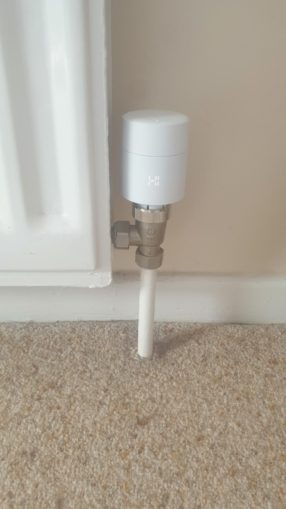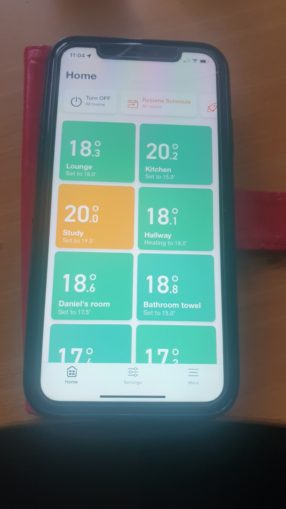With the current ridiculous cost of heating and a house that is usually half-empty, I decided to see what could be done. We had a new combi boiler installed earlier in the year, replacing a 20 year old beast that was advanced for its time. We hadn’t changed the thermostat in the hallway as it worked. It seemed a bit rubbish to be running that new kit on a 20 year old basic heating timer.
Disclaimer – I am not being paid or rewarded to do this review by anyone!
Most houses that have gas heating will have a boiler with hot water tank or a combi that heats water when needed. In either case the heating of the house is controlled by two elements – a timer looking after the whole house and usually Thermostatic radiator valves (TRVs) that close when a set temperature is reached. They’re ideal if you are in the house all of the time and your room usage is constant.
My thought was why do we heat every room both in the morning and at night – we don’t use the lounge in the morning but it, along with every other room gets to their set temperature based upon the timer between 6.30am and 8am then from 4pm to 10pm. What Smart Thermostats allow you to do is an individual controller for each room, completely separate to the rest of the house, setting any temperature at any time of day or night – so leave the lounge cool until tea time, similarly warm the bedrooms an hour before bed, or have the towel radiator on for half an hour in the morning, and the same at night – endless flexibility which will mean rooms are not heated unnecessarily. You also get added features such as the heating shutting down if everyone leaves the house, and much more precise temperature control rather than everything based upon the view of a draughty hallway.

There are a few options on the market. I’d suggest you read the reviews carefully, as this is still quite a new technology. What you have is a small wifi link that plugs into your broadband router, that talks to all the devices. Your boiler is controlled by a new controller and each radiator you decide to convert has the TRV top swapped for a wifi one. You don’t have to do everything at once. Convert the boiler and a few radiators initially and add to that later if you need.
A number of companies supply systems, they are unlikely to be compatible, though the level to which you convert is flexible. Companies such as Drayton, British Gas, and Bosch now sell them, some are pricey, some really ugly! In the end I went for a system by a company called TADO, it was around the middle of the price range, had a quality, unobtrusive finish, decent software features and good reviews. It is somewhat expensive – the ‘Tado v3+ wireless heating and hot water kit at £189, comprising a boiler control that is wired to your boiler, a thermostat and the wifi connector. I think a standard old boiler controller costs about £100. These items are often on offer – the starter kit at time of writing selling on Amazon for £129. Consider how many radiators you want to control – if you have some places that doesn’t need heating at all, you could just turn down the existing valve and keep it cold. The thermostats are between £55 and £75 each depending upon special offers and the number you purchase at once. Check delivery dates on them carefully as many are currently out of stock. I had ‘on sale’ purchases from people like Victoria plumbing only to find the delivery date was a month later.

Why bother with all this? Well if you are working from home or use different parts of the house at different times, they approach the heating in a very different way to the past. When I’m working in a room, I can set that room to a comfortable temperature and that radiator valve will open and instruct the boiler to fire up so really only that room is heated. As a safeguard you do still have to have one radiator completely unrestricted – we set a small towel rail – in case the boiler gets confused and fires up while all valves are shut – that’s not going to do the pump any good… That idea of radiators requesting on demand rather than everyone getting heat at set times is a big change in mindset. The gas engineer I had install the control had one in his house and admitted it was a big change in thinking how they are set up.
Another useful feature is ideal for those with teenagers. My son is notorious for having the heating on full, then opening the windows when it is too hot – the heating still blasting. These valves notice the drop in temperature and humidity, and shut down that room. If you all leave the house they scale back to a lower temperature, even raising it as you near home again. You can also put a child lock on each radiator so it ignores anyone playing with it direct.
How do you control all of this? Not some tiny lcd screen and dead flesh buttons on a controller halfway up the hallway. Naturally like everything else these days it is via an app.

As a tech nerd, information is always of interest. The App tells me the temperature and humidity in each room, the temperature it is aiming for and clicking on that room lets me adjust that using a slider – be that for a period of time, until the next time slot or until I change it back. You can change one or all rooms at the same time and can see the history of temperature and humidity in graph form.

There is much more I’m sure I’ve not seen yet – such as the fact it takes outside temperature into account when looking to start heating, reporting back on anything unusual or if the batteries in a device are on the way out. It also lets you track the expense – put your gas bill in and last year’s numbers and it’ll calculate savings made. Tado claim an average saving of between 26% and 31% Payback is probably more than a year, though with our energy bill forecast at over £3000 I might be surprised. You can hook it up to Alexa or Siri – if you have a spy in the house.
Installation was fairly easy, though I did get a heating engineer to wire the controller to the boiler and swap a couple of non-TRV valves for me. Other than that you simply unscrew the top of the TRV valve, add a base (lots of adapters for different makes), scan a barcode on the new valve top and plug it in. It registers against your system and you name that room. You can have more than one radiator working together, say in a large room, have one controlling temperature and they work in unison. You can share that app with other family members so they also have control.

So it all sounds great, what is it like in reality?
At first I was a bit paranoid, checking every few minutes, and not without good reason. As well as the controls taking a little time to learn your living patterns, we did have a glitch or two. If the boiler controller loses contact with the wifi it will continue in the current state – so if it was on, it stays on. Nice to wake up at midnight and find the place warm but not what I was aiming for. I found the wifi connector being wedged behind a couple of monitors in the far corner of the house wasn’t central enough and occasionally lost contact. Moving it to a coat cupboard in the middle of the house, plugged into a powerline socket (that means electricity and internet signal through the wiring in your house) fixed the issue. Just to be sure I also moved the boiler wireless controller into the kitchen, so close to the boiler – not sure the point of that bit of kit when the radiators are doing it for themselves but there you go.
What happens if the wifi goes off? You can manually override everything on each device so shouldn’t be stuck. It will continue in it’s programmed state until wifi returns, or you override things.
The only other quirk I found was when I manually altered a time schedule. It remembered that setting for next time – fine, but having gone away for a few days, I’d set the override to ‘until I change it manually’. Next time I assumed it would be until the next time slot, but it was waiting for me to change it again so another reason to wake up hot in the night! Just one to keep in mind and check you’ve set it back if changing that setting.
The valves themselves do make a one second whirring noise as they open and close – it is not too loud, but could be disturbing for some in the bedroom. We have put them in there, only setting it to start when the alarm goes off.

Am I happy with it – yes. With the recent really cold snap, it dropping to -4 and not getting above freezing outside for a week, the boiler coped well. The heated rooms stayed warm. I did need to work out the best temperature for bedrooms – in the end 18.5C for an hour before bed was about right. Those rooms that are heated – fine – quickly rise to temperature. Those that are unheated, we can monitor on the app, over time and cold weather, they slowly dropped to as low as 7 or 8 degrees. The frost protection will kick in but I did occasionally set them to 10 or 12c for an hour or two and kept an eye on the humidity. With the clan about to return for Christmas, warming their rooms will take a few days to get all the cold and damp out of the furnishings – copying and pasting the time schedule for a heated room quickly set them up.
Would I recommend it – yes I do. The App is easy to use and has lots of features and information. Even Mrs. SD uses it without complaint. Buy spare batteries, as you will find one or two sets fail quickly – you have no idea how long they’ve been stored for sale. Do check Youtube for various people’s experiences of all the various brands.
Tado themselves provide a lot of support – on the app, online and via a call/email centre. I would imagine they’re pretty busy at the moment but email queries were usually replied to in around 24 hours. There are plenty of guides and comparison videos so do some research before you purchase.
PROGRAMMABLE SMART THERMOSTATIC RADIATOR VALVES – TADO° Review – YouTube
We did spend more than planned – going overboard on the number of radiator controllers (we have 11 of them now running 10 rooms) and I went wild and took the £24 a year subscription that adds a few extra features – automatically shutting the heating when you leave, when a window is open and monitoring for issues etc. I probably won’t renew that, but thought it worth trying out. If you don’t make that payment, you still get notifications suggesting you manually shut off that room or the heating as all are out.
I do expect it to save some money. The improvement in control and information is a useful secondary benefit so no regrets so far!
© Sweaty Dave 2022
The Goodnight Vienna Audio file



